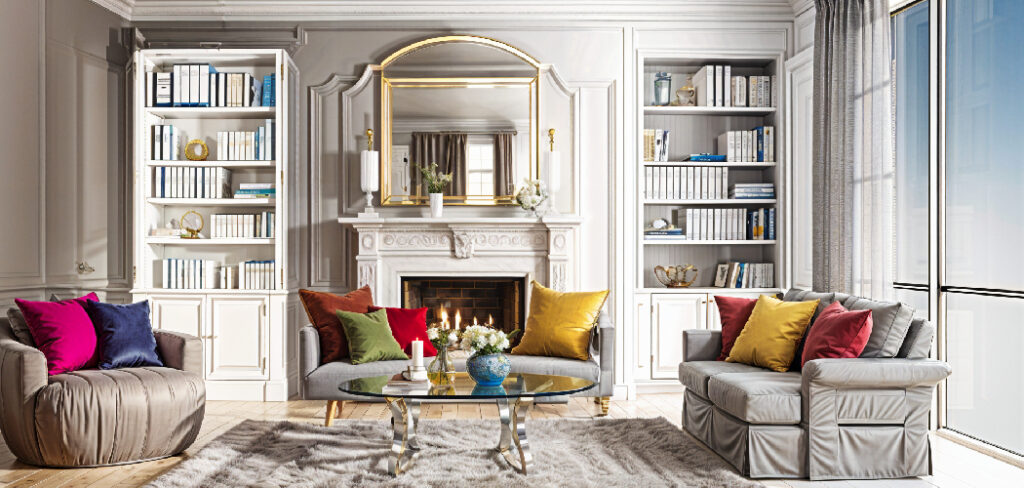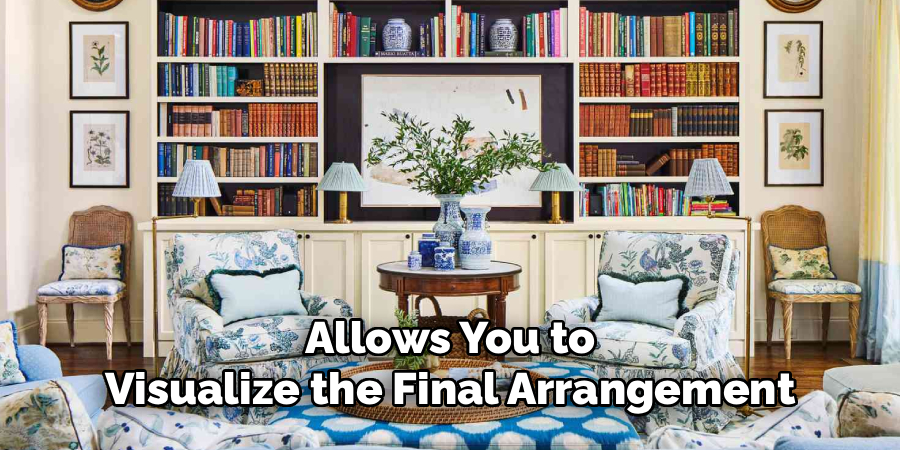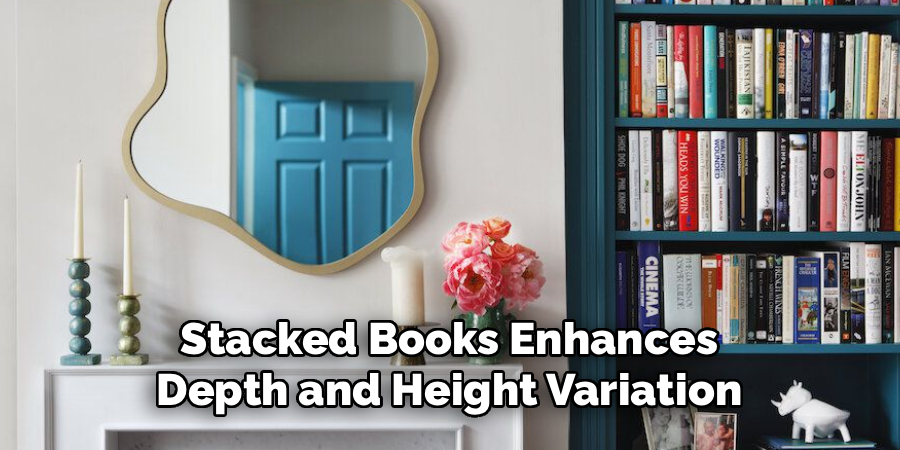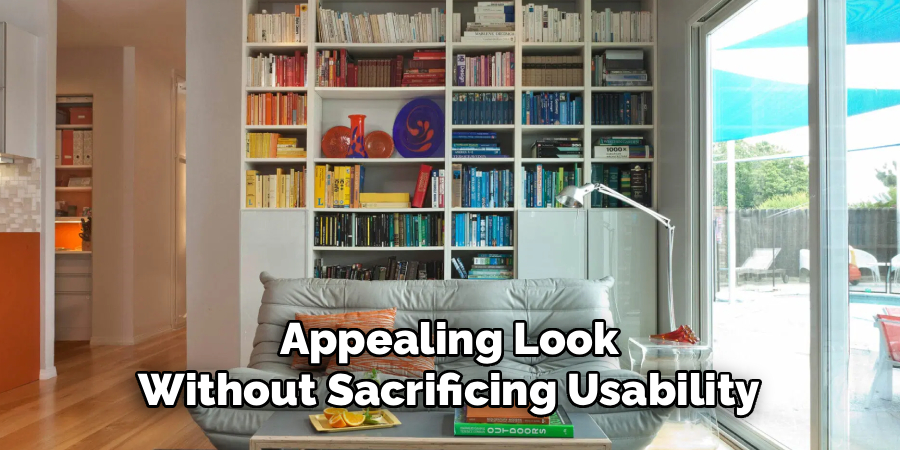A bookshelf is far more than just a storage unit for your books; it is a canvas for creativity, style, and personality. When approached thoughtfully, it can transform the living room by adding depth, color, and a sense of narrative to your space. Learning how to decorate a bookshelf in a living room allows you to combine function and design, turning simple wooden planks into a striking focal point.

With proper arrangement, your shelf can showcase books, personal mementos, decorative items, and even small indoor plants, making the room feel curated and inviting. This guide will help you approach your bookshelf as a design element, ensuring that every item has a purpose and every shelf tells a story.
Benefits of Decorating a Bookshelf in a Living Room
Decorating your bookshelf has several key benefits that enhance both the aesthetics and functionality of your space.
First, it improves visual appeal. A well-curated shelf balances vertical and horizontal lines while leaving enough negative space, preventing clutter. Grouping items by color, size, or texture provides cohesion and creates a visually stimulating arrangement.
Second, it helps personal storytelling. Items such as travel souvenirs, framed photos, heirlooms, or small art pieces convey personal history. Guests can understand your tastes and hobbies simply by glancing at the shelves, transforming a functional corner into a conversation starter.
Third, it introduces texture and dimension. Mixing materials like glass, metal, wood, and ceramics adds tactile contrast. Varying the height of objects on wooden planks or stacked books softens the rigid lines of the bookshelf, creating depth and making the display engaging from every angle.
Finally, a decorated bookshelf improves organization and usability. Strategically placed storage baskets, bookends, and trays conceal clutter while keeping your collection accessible. By blending form and function, your bookshelf becomes an integral, beautiful part of the living room’s design.
Tools and Materials You’ll Need
- Decorative Accessories: Picture frames, small sculptures, vases, bowls, and unique found objects.
- Bookends: Heavy or eye-catching items such as stone, marble, or geometric metal shapes.
- Storage Baskets/Bins: Woven, canvas, or felt containers to hide clutter like remotes and cables.
- Houseplants: Succulents, pothos, or small air plants for a touch of greenery.
- Stacking Boxes or Trays: Small risers to elevate items and add height variation.
- Cleaning Supplies: Microfiber cloths, dusters, and optional polishing products.
- Optional Tools: Museum wax, wall putty, or small clamps to stabilize top-heavy objects.
7 Step‑by‑Step Guide: How to Decorate a Bookshelf in a Living Room

Step 1: Clear the Shelves and Define Your Palette
Begin by removing all items from the bookshelf. Treat the empty wooden planks as a blank canvas. Cleaning the shelves with a microfiber cloth removes dust and allows you to visualize the final arrangement. Next, choose a cohesive color palette that complements your living room. Limit your selection to three primary colors, often inspired by the sofa, rug, or wall paint. This restriction provides a sense of order and makes the styling process less overwhelming.
Discard or temporarily store items that don’t match the palette. By starting with a clean slate and intentional color choices, you lay the groundwork for a visually balanced and aesthetically pleasing shelf. Think of this step like applying primer before painting; it creates the necessary foundation for everything that follows.
Step 2: Organize Books with Intention
Books are the backbone of your display, but placement matters. Arrange roughly 60% vertically and 40% horizontally to create rhythm and variety. Horizontal stacks act as pedestals for decorative objects, adding height and depth. Consider grouping books by color or size rather than content to maintain a cohesive appearance. Monochromatic stacks provide clean visual breaks, while taller or wider volumes add structure. Always leave some negative space to prevent the shelf from feeling cramped. Proper placement ensures your books are both functional and part of a harmonious design.
Use stylish bookends to anchor vertical books and prevent leaning. Remember, a carefully arranged bookshelf showcases your collection while offering opportunities for artistic expression with accessories.
Step 3: Implement the Rule of Three and Odd Numbers
Clusters of three, five, or seven objects create visual interest. Odd-numbered arrangements feel dynamic and balanced, unlike even pairings that often appear static. Within each grouping, vary the height, size, and texture of objects. For example, a tall glass vase paired with a medium framed photo and a small ceramic bowl forms a natural triangle that guides the eye. Using horizontal books or small risers elevates objects slightly, adding dimensional contrast.
Avoid placing items of identical height next to each other. This simple design principle makes each cluster engaging while maintaining cohesion. Through repetition of this rule across shelves, the display achieves an organic flow, preventing monotony while emphasizing curated, purposeful styling.
Step 4: Mix Textures and Materials
A dynamic bookshelf balances diverse textures and materials. Combine smooth glass, reflective metal, rustic wood, and woven elements to create depth. Negative space is equally critical, allowing each object to stand out. Aim for roughly 60% objects and 40% space on each shelf. This balance ensures the display is visually breathable, preventing clutter. For instance, a stack of books topped with a glossy ceramic sculpture juxtaposed with a rough rattan basket introduces tactile contrast. Even small details, like a polished picture frame beside a rough-textured bowl, enhance sophistication. Proper material mixing transforms simple wooden planks into a multi-sensory design element that invites closer inspection and appreciation.

Step 5: Add Greenery and Personal Mementos
Houseplants and personal items bring warmth and life. Small succulents, trailing vines, or air plants introduce vibrant color and soften rigid lines. Personal mementos like framed travel photos, inherited artifacts, or collectible items create a story unique to your home. Integrate these pieces into odd-numbered clusters to maintain balance. Placement should consider height, depth, and proportion. A small potted plant might sit atop a horizontal stack of books, while a cherished keepsake can anchor a larger vertical grouping. The goal is a cohesive narrative that blends greenery, books, and personal artifacts seamlessly. This approach ensures your bookshelf feels authentic and inviting rather than purely decorative.
Step 6: Use Decorative Storage for Functional Items
Even the most curated bookshelf may house remotes, charging cables, or small gadgets. Stylish storage solutions such as woven baskets, decorative boxes, or canvas bins hide clutter while contributing texture. Matching containers reinforce symmetry and prevent the display from appearing haphazard. Place bins on lower shelves for balance, leaving the upper shelves visually open. This step ensures the bookshelf remains practical while maintaining an organized, magazine-worthy appearance. Well-chosen storage adds subtle warmth and complements wooden planks, painted surfaces, or metal shelving frames, tying the functional and aesthetic elements together cohesively.
Step 7: Optional Color Styling
For a bold, modern look, color-block your books by spine color or create a gradient effect. Group similar shades together or transition smoothly across the shelf. Complement these vibrant sections with neutral decorative pieces to prevent visual conflict. This technique works especially well in minimalist or contemporary living rooms. Color-blocking draws attention to the bookshelf as an artistic feature, while maintaining balance with curated objects like ceramics, frames, or small sculptures. Though optional, this approach transforms the bookshelf into a cohesive, visually striking focal point. It elevates wooden planks beyond storage, emphasizing the bookshelf’s role in your living room’s aesthetic story.
Customization Tips
Keep your bookshelf dynamic with seasonal or thematic rotations. Reverse shelving, where books face inward, can neutralize busy spines. Dedicate a shelf to collectibles such as vintage cameras, teacups, or small sculptures for an added personal touch. Lining the back of the shelf with removable wallpaper, fabric, or decorative paper introduces subtle patterns without permanent changes. Incorporating small battery-powered LED lights highlights objects and adds a cozy ambiance. Using risers like trays or stacked books enhances depth and height variation. These small customizations make your display adaptable and personal while ensuring every shelf feels curated and intentional.

Common Mistakes to Avoid
- Overcrowding the shelves, which diminishes negative space and visual appeal.
- Placing objects of the same height consecutively, creating monotony.
- Neglecting cleaning, leading to dust accumulation and loss of polish.
- Ignoring color palettes, resulting in a cluttered, chaotic display.
- Displaying too many small items, which overwhelms the viewer instead of telling a cohesive story.
Frequently Asked Questions
1. How many objects should I place per shelf?
A good rule is 60% objects and 40% space. Odd-numbered clusters (3, 5, 7) are visually appealing. Avoid overcrowding to ensure each piece stands out. Using a mix of vertical and horizontal book arrangements also helps maintain balance while providing platforms for decorative items.
2. Can I mix modern and vintage items?
Absolutely. Combining modern materials like glass or metal with vintage wooden objects or antique trinkets adds interest and texture. Ensure there is a unifying color palette to prevent clashing. Odd-numbered clusters help blend diverse items harmoniously.
3. What size plants work best on bookshelves?
Small to medium potted plants such as succulents, pothos, or air plants work well. They add color and soften hard lines without overwhelming the shelf. Trailing plants can cascade slightly for a natural effect, while small pots can be elevated on horizontal book stacks.
4. How do I prevent objects from tipping over?
Use bookends, museum wax, or wall putty to stabilize heavier objects. Horizontal stacks of books can also act as risers to support smaller sculptures or framed photos. Placing fragile items in the center of a shelf reduces the risk of accidental knocks.
5. Should I organize books by topic, size, or color?
It depends on your goal. Color organization creates a striking visual gradient. Size arrangements maintain balance and structure, while topic or author arrangement prioritizes function. Combining methods with decorative objects ensures a curated, appealing look without sacrificing usability.

Conclusion
Learning how to decorate a bookshelf in a living room allows you to turn a simple wooden structure into a personalized, visually captivating centerpiece. By starting with a clean slate, applying the Rule of Three, integrating diverse textures, adding greenery, using functional storage, and leaving negative space, your shelves become organized, stylish, and reflective of your personality. Optional color-blocking or seasonal rotations can elevate your display further

About
Emmett Finn is a distinguished figure in the world of Diy design, with a decade of expertise creating innovative and sustainable Diy solutions. His professional focus lies in merging traditional craftsmanship with modern manufacturing techniques, fostering designs that are both practical and environmentally conscious. As the author of diy, Emmett Finn delves into the art and science of furniture-making, inspiring artisans and industry professionals alike.
Education RMIT University
(Melbourne, Australia) Associate Degree in Design (Emmett Finn) Focus on sustainable design, industry-driven projects, and practical craftsmanship. Gained hands-on experience with traditional and digital manufacturing tools, such as CAD and CNC software.
Nottingham Trent University
(United Kingdom) Bachelor’s in diyfastly.com and Product Design (Honors) Specialized in product design with a focus on blending creativity with production techniques. Participated in industry projects, working with companies like John Lewis and Vitsoe to gain real-world insights.
Publications and Impact
In diy, Emmett Finn his insights on indoor design processes, materials, and strategies for efficient production. His writing bridges the gap between artisan knowledge and modern industry needs, making it a must-read for both budding designers and seasoned professionals.

Very Good.
nice.
thanks